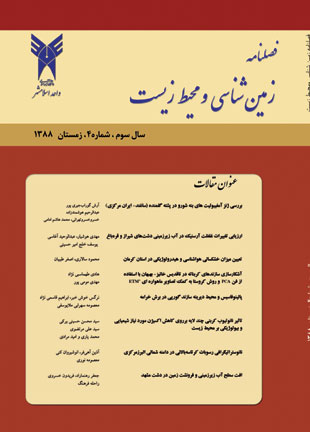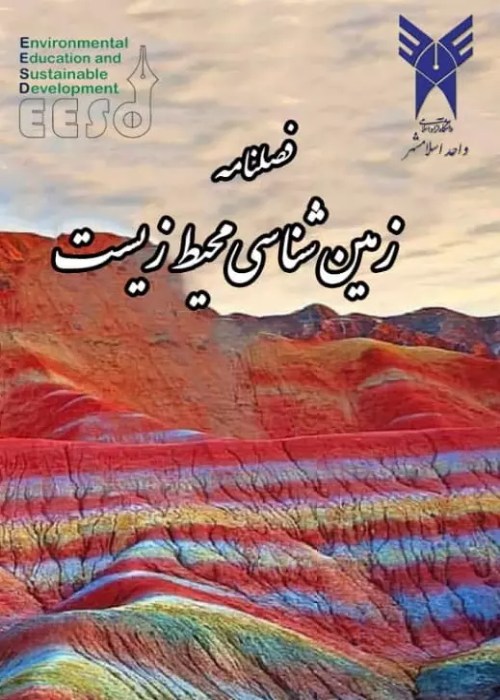فهرست مطالب

نشریه زمین شناسی محیط زیست
پیاپی 9 (زمستان 1388)
- تاریخ انتشار: 1388/10/11
- تعداد عناوین: 8
-
Page 1The Gelmandeh Massive is a low relief high located north-east of Saghand, in Yazd province..From the point of view of structural geology, it is part of "Central Iran" the Kalmard_Posht-e Badam Block, east of the Posht-e-Badam Fault. This structural high is composed of a combination of metamorphosed sedimentary rocks, amphibolites and pink quartzific and feldspatic gneissic. The characteristic of the mica schist is the high percentage of re-criticized quartz and large, bent muscovite crystal. This unit is seen in close proximity of muscovite of an amphibolites complex, which is divided in two the fallowing three parts: 1) hornblendite with excess of 90% hornblende 2) garnet-amphibolites (containing) oligoclase, tschermakite and hastingsite variety of hornblende and large, brown garnets of almandine-grossularite type 3) Grey banded amphibolitic gneiss with augen texture. Field observations and geochemical studied point to a magmatic protolite for the amphibolites but of two different origins: 1) Basaltic with calcalkaline & potasic calcalkaline affinity derived from an enriched mantle 2) basaltic with calcalkaline to tholeitic affinity with crustal contamination. Both are of within plate variety, produced by "hot spot affected the crest in two different timeKeywords: Saghand, Gelmande massive, Origin, Garnet Amphibolite, Boneh shorow, Rich mantle
-
Page 19The study region is Shiraz and Gharehbagh plains in Fars province. Most significant water requirments, especially drinking water in these regions supply are supplied with groundwater resource. In order to estimating of Arsenic contamination between water resource of the region has been done sampling from 25 resource during 4 periods in a year. These sample were analyzed with ICP method. After laboratory investigating and the comparison of outcomes to WHO standard detected highly contamination with Arsenic in groundwater. With using of contamination zonation maps of Arsenicconcentration in these regions distribution of this element could be observed easily. The distribution of the abovementioned element has not equal in different periods of sampling but significant point is increasing of its concentration at 2-3 month after sufficient rainfall.Keywords: Shiraz, Gharehbagh plains, Arsenic, Pollution
-
Page 31Although kerman, as a part of Iran Plateu, has a dry to very dry climate, few changes happen in its climate due to some factors including height, humidity and weather fronts enter this region; in this case, dry and rarely mediterianian climates can be seen in heights of Lalehzar and Jabalbarez Mountains. To determine metropoligical drought, Kerman Province has been divided into suitable sub-basins and Regional Evaluation Statistical Distribution Method has been used. Moreover, Regional Evaluation has been examined using Standard Distribution Index, arithmetical mean and ratio median.In this survey Rainfall stations with suitable distribution with a long period of meteorological drought statistics between 1968-2007 for 39 years are selected.the surveys showed that the drought period in Kerman is longer that wet year period.More over by selecting 4 index hydrometry stations with acceptable statistics and generalizing to four region of Kavir lut,Jazmorian,Daranjir desert,Sirjan Abarghoo desert were determined.Since the 1999-2000 Kerman region entered drought hydrological situation that continued till 2007-08 and the surface runoff production inadequancy rate to the long period.average were determined to 18 billion cubic meters, and the years of 1968-69, 1999-2000, 2005- 06, 2007-08 were the driest years and in most years, some portious of state had beared some drought with different return period.Keywords: meteorological drought, hydrological drought, sub, basins, index rivers, kerman
-
Page 43Detection of carbonate formations, especially in area located next to clay formations is essential. Because the data set to estimate mining stocks and determinate of exploration programs are necessary. In this study, for detection of carbonate formations and their separation from clay formations, Image classification and principle component analysis (PCA) and Crosta techniques the help of ETM+ satellite images of Landsat 7 is used. For this purpose, several psedo-color composition of the Khaeez anticline of Behbahan city located in geological zone of Zagross, has been created in ENVI software. For classification of satellite images of case study, maximum similarity method was used. Then, selecting a series of known sample pixels and comparing their class with classification results and calculating Kappa coefficients, classification results were evaluated. These results indicate classification accuracy of Carbonate formations is medium that may be a result of vegetation cover on these formations.Keywords: ETM+ Satellite image, Crosta method, Principle component analysis, Behbahan
-
Page 55Gurpi formation of kharame section is located in 84 km east of Shiraz, classified to 5 zone by using of foraminifers. Because palinomorphs arent preserve completely. Presence of Globotruncana elevate in the base of section was showed early Campanian for Gurpi formation. The upper boundary of Gurpi formation was determined of Tarbour formation by Gunsserina gansseri. For Palynofacies investigative on the Gurpi formation Tyson (1993) Diagram was used which is based on AOM (Amorphous Organic Matter), Phytoclasts (Spore, Pollen, wood particle) and Palynomorphs (Dinoflagellate, Acritarchs and chitinous inner linig of foraminifera) percentage. Based on these, three Palynofacies were distinguished and differentiated showing a Palaeoenvironment ranging from marginal dysoxic – anoxic to distal suboxic – anoxic basin. As marine Palynomorphs are not well-preserved they could not be used for biozonation. Zonation and age dating were then based on foraminifera based on which five biozones showing in general an age of Early Campanian-Early Maastrichtian was determined for the formation.Keywords: Gurpi formation, fars, Paleoecology, palinologic facies
-
Page 69Carbon nanotube is unique structural and ability to removal of different pollution from soil and water. Also this pore structure matter is not to made pollution soil and environmental. When pollution is diffusion to soil is made environmental recycle water. Wastewater dairy industry is defined as the water, which is polluted by different organic or inorganic chemical compounds. Majority wastewaters come from start –up and shutdown operations performed in the pasteurization process,equipment and tankcleaning. The nature of dairy processing is such that a large volume of high strength effluent is discharged from the factory, this wastewater is invariably high in organic material (e.g. oils and fat, dissolved sugars and proteins, and possibly residues of additives etc.) and consequently has a high biological oxygen demand. Hence disposal of untreated dairy wastewater with high biological oxygen demand concentrations or treatment of it at source to a satisfactory level will be very importantin preventing future environmental pollution. The treatment of wastewater with a high degree of operational reliability is now in demand all over the work. At the same time, preconditions are becoming more important. These apply to the limitation of sludge yield, energy consumption and space consumption. The reclamation of energy has been demanding increasing attention. In this research, used multi walled carbon nanotubes for reduction biological and organic load (BOD5 and COD). The result indicated is good as adsorbent and redaction contamination.Keywords: Environmental, Dairy industrial wastewater, adsorption, multi walled carbon nanotube
-
Page 77Taking into account the extent of upper cretaceous deposits of Alborz region, determination of stage boundaries within the successions at different parts of the basin by the use of calcareous nannoflora was put on the agenda. Two stratigraphic sections viz. Alamde galandrud and Pol e zoghal were sampled at predetermined intervals. back to the laboratory, the samples were prepared using gravity settling technique and the resulting thin sections. The nannofloral assemblage of the upper cretaceous rocks of northern Alborz region reveal coniacianmaastrichtian age at Pol e zoghal (west) and campanian-early paleocene age at Alamde galandrud (east). moreover, the region was situated at low paleolatitudes and experienced a low marginal environment of deposition at the said time. the outcomes of nannostratigraphic investigations carried out in Pol e zoghal section along with the resalts of earlier studies in Alamde galandrud reveals that during the late cretaceous times the depositional center of the basin was lacated on the west and gradually shifted towards east. (i.e. sedimentation started earlier in the western parts and lasted longer in the eastern parts of the basin during late cretaceous times.)Keywords: upper cretaceous, Polezoghal section, Alamde galandrud section, calcareous nannofossils, paleogeography


